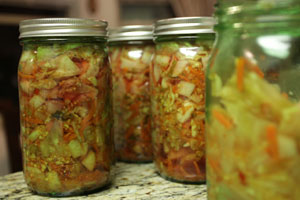 Here’s something that could actually make your life spicier, healthier and more self-sustaining.
Here’s something that could actually make your life spicier, healthier and more self-sustaining.
In our ongoing gardening and homesteading project, we found that our cover crop, Daikon Radishes, grew in abundance and we didn’t know what to do with them all. Some of our friends suggested we try making Kimchi – Korea’s national dish.
But we had never tried it… and were skeptical.
We had already started fermenting vegetables to benefit from the long shelf life, homemade probiotics and more bioavailable vitamins and minerals.
However, Kimchi was a whole new ballpark. Fortunately, it was successful and very tasty as well. Good for digestion and general good health!
Watch the video:
Here’s a few items you might need to grow your own organic Daikon radishes (really, they grew effortlessly):
3g (Approx. 300 – 360) Giant Daikon Radish Seeds “Minowase/ Summer Cross” Very Low in Food Energy, Extremely Dietary Vegetable, Heirloom. ‘Fresh Seeds – Best Before 12.2017!’
Earthworm Castings, 15 lb (Pure Gold for Organic Farming)
And just a couple items to get started with canning vegetables for fermentation:
Ball Heritage Collection Quart Jars with Lids and Bands, Green, Set of 6
Ball Mason Jars Wide-Mouth Can or Freeze – 16 oz 12pk
Tattler Reusable Wide Mouth Canning Lids & Rubber Rings – 12/pkg
The Spice Lab Finely Ground Pure Himalayan Salt, 2 pounds
Celtic Sea Salt Bag, Light Grey, 5 Pound
All-in-one kit options:
Small Batch Fermentation Kit
Perfect Pickler® Fermenting Kit
Raw Rutes – Sauerkraut Starter Kit
Probiotic Starter Cultures for Fermented Vegetables
The vegetables used in your recipe naturally contain lactobacillus, but are multiplied during submersion in the saltwater brine, and that is a big part of what makes these foods so healthy and desirable.
Dr. Mercola, a big proponent of making your own fermented foods, explains:
Ninety percent of the genetic material in your body is not yours but belongs to the bacteria that outnumber your cells 10 to 1. These bacteria have enormous influence on your digestion, detoxification and immune system.
Moreover, your gut literally serves as your second brain, and even produces more of the neurotransmitter serotonin—known to have a beneficial influence on your mood—than your brain does, so maintaining a healthy gut will benefit your mind as well as your body.
But, if you are making Kimchi and other fermented foods for their probiotic value, please note that you can add starter cultures to the batch to greatly increase the number of strains and count in your fermented foods.
The two most highly recommended brands, recommended in countless blogs on fermented foods, are sold in packets by Body Ecology and Caldwell’s Vegetable Starter Culture
.
Dr. Mercola found numbers as high as “10 trillion colony-forming units of bacteria” using starter cultures – making one serving of food as potent as any high dollar probiotic supplement (though many are worth the money). Mercola wrote, “literally, one serving of vegetables was equal to an entire bottle of a high potency probiotic!”
“There are about 100 trillion bacteria in your gut, so a single serving can literally “reseed” 10 percent of the bacterial population of the average person’s gut! To me that’s extraordinary, and a profoundly powerful reason to consider adding fermented vegetables as a staple to your diet.”
However, these starter cultures do cost money and are not necessary to creating a healthy, probiotic rich batch of fermented foods. It may be something you choose to experiment with after starting your fermentation process…
Aaron’s Recipe: How to Make
There are lots of Kimchi recipes out there [1, 2, 3], but this one included:
1. Brine, to submerge cabbage and radishes, then add to jar to level above veggies and an inch below top of jar
Brine made from: a) Purified, flouride free water or spring water
b) Himalayan Sea Salt (1-2 tbsp.)
c) Cabbage juice (pounded out from cabbage, and leached out by salt)
2. Primary veggies, cubed; this batch was enough for 4 quarts:
Organic Cabbage (cubed, green and purple)
Homegrown, organically-farmed Daikon Radishes (cubed)
Organic Carrots (chopped into matchsticks)
3. Diced and Chopped Secondary Veggies
– diced in food processor – and mixed in with cabbage/radishes
Organic Garlic (4 cloves or so, …)
Organic Ginger (about 1 inch)
Dried Chili Peppers (or fresh if you like) (2 or 3 or so…)
Organic Scallions (green onions) (2 or 3 stalks chopped and mixed in)
Organic Onion (yellow, white or red) (half or whole, diced or chopped)
+ 1 TBSP Chili Powder (online site recommended against cayenne; recommended getting it from the Asian grocery section; I got mine from the Hispanic grocery section)
4. Mix thoroughly in large bowl/dish, tossing cubed veggies with diced veggies into brine
5. Add to jars, packing in to remove as much air as possible
6. Fill with salt water brine to just below top (about an inch from top of jar) and enough to cover veggies
7. Optionally, add medium-large cabbage leaf as “lid” to cover and hold veggies from floating to the top
8. Seal with lid, put in dark corner or closet at room temperature
9. “Burp” out carbon dioxide after a day or two, otherwise, the lid may bend with pressure, and could “in theory” actually explode (though this is unlikely… come on)
10. After 4-7 days, it is probably ready. Taste and enjoy, or leave fermenting for a longer period to adjust flavor.
11. Store in fridge, eat before meals, to help with digestion or as a snack
12. Experiment with other veggie and spice combinations… it adds lactobacilli probiotics, to help win the war in your intestine for good health.
This article was originally published at Ready Nutrition™ on December 19th, 2014






